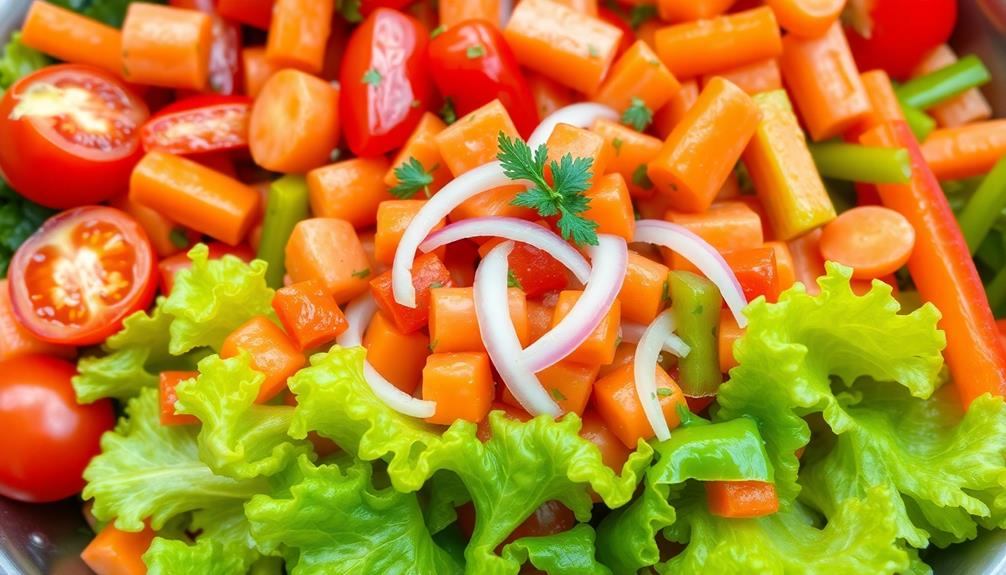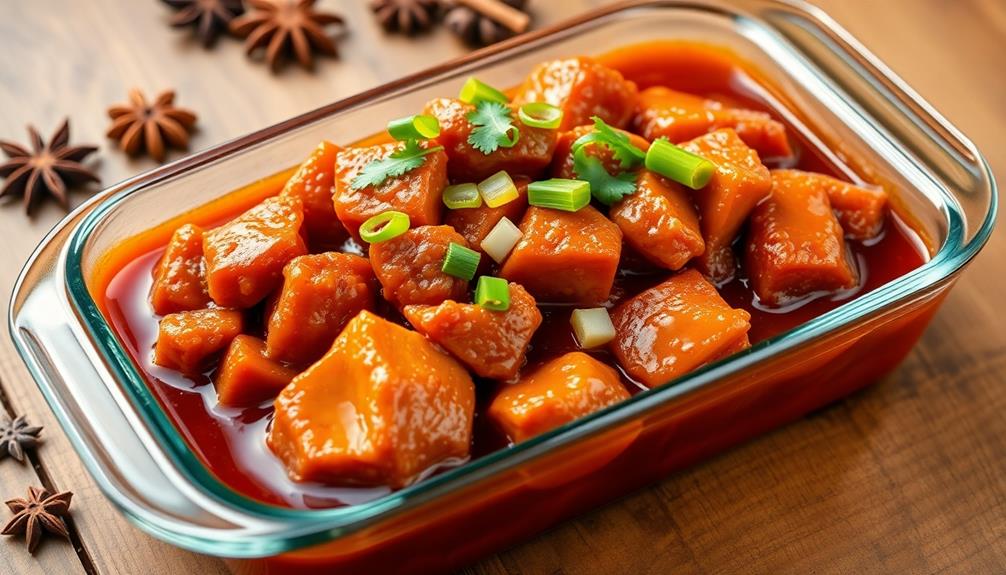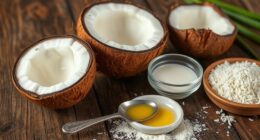Embark on a tantalizing journey as you discover the unique flavor profile of Vietnamese yogurt! This creamy delight combines the freshness of high-quality milk with a delightful balance of sweetness and tanginess, creating a truly captivating taste experience. The natural ingredients harmonize seamlessly, offering a refreshing and indulgent treat that appeals to a wide range of palates. Whether you enjoy it on its own or pair it with fresh fruits and crunchy granola, Vietnamese yogurt promises a sensory adventure that'll leave you craving more. Intrigued? Keep reading to uncover the rich history and preparation of this beloved culinary treasure.
Key Takeaways
- Vietnamese yogurt's signature flavor profile combines a delightful balance of tangy and sweet, created through the use of locally sourced ingredients and traditional preparation methods.
- The creamy texture and natural ingredients used in Vietnamese yogurt contribute to a captivating sensory experience that appeals to a wide range of palates.
- Vietnamese yogurt's distinct flavor profile, which sets it apart from other yogurt varieties, is a reflection of the rich culinary heritage and diversity of the country.
- The fermentation process and careful attention to temperature control during preparation are crucial in achieving the unique flavor and consistency of Vietnamese yogurt.
- Vietnamese yogurt is not only a beloved household favorite but also a cultural symbol that represents the importance of freshness and regional variations in Vietnamese cuisine.
History

The history of Vietnamese yogurt can be traced back to the early 20th century, when French colonists introduced the dairy product to the region.
As the locals embraced this new delicacy, they began experimenting with unique flavor profiles, blending the tangy yogurt with local fruits, herbs, and spices. This fusion of cultures birthed the distinctive taste that Vietnamese yogurt is known for today.
Over the decades, the art of yogurt-making has been passed down through generations, with families perfecting their recipes and techniques.
From the bustling cities to the rural countryside, Vietnamese yogurt has become a beloved part of the nation's culinary heritage.
Whether enjoyed as a refreshing snack or incorporated into traditional desserts, this creamy treat continues to delight the taste buds of locals and visitors alike.
Recipe

Vietnamese yogurt is a unique and delightful dairy product that has gained popularity worldwide. Its distinctive flavor profile is a harmonious blend of tanginess, creaminess, and a subtle sweetness that sets it apart from other types of yogurt. This recipe will guide you through the process of creating your own authentic Vietnamese yogurt in the comfort of your own kitchen.
The key to achieving the perfect Vietnamese yogurt lies in the careful selection and preparation of the ingredients. By following this recipe, you'll be able to capture the essence of this beloved treat and indulge in its refreshing and satisfying goodness.
Ingredients:
- 1 quart (4 cups) of whole milk
- 1/2 cup of sweetened condensed milk
- 1 tablespoon of plain yogurt (as a starter culture)
- 1 teaspoon of vanilla extract
Cooking Instructions:
In a medium saucepan, heat the whole milk and sweetened condensed milk over medium heat, stirring frequently, until the mixture reaches 180°F (82°C).
Remove the pan from the heat and let the mixture cool down to 110°F (43°C). Gently stir in the plain yogurt and vanilla extract until well combined. Remove the pan from the heat and let the mixture cool down to 110°F (43°C). Gently stir in the plain yogurt and vanilla extract until well combined. Allow the mixture to rest for a few minutes to ensure the flavors fully meld together. This step is particularly important if you’re using this as a base for an earl grey pie recipe, as it sets the foundation for a smooth and creamy texture. Once ready, proceed with the next steps to assemble the pie or store the mixture as needed.
Pour the mixture into clean, sterilized jars or containers. Cover the containers and place them in a warm, draft-free environment (such as an oven with the light on) for 6-8 hours, or until the yogurt has thickened to your desired consistency.
Tips:
For a thicker, creamier yogurt, you can strain the finished yogurt through a cheesecloth or fine-mesh strainer to remove any excess whey.
Additionally, you can experiment with different flavors by adding fresh fruit, honey, or other aromatic ingredients to the yogurt before the final fermentation step.
Enjoy your homemade Vietnamese yogurt chilled and as a refreshing treat or use it in various dishes and desserts.
Cooking Steps

First, you'll need to combine the milk, sugar, and yogurt culture.
Next, let the mixture incubate at the perfect temperature until it transforms into a delightful yogurt.
Step 1. Combine Milk, Sugar, and Culture

Once you've gathered your ingredients, you'll want to combine the milk, sugar, and yogurt culture in a large pot. This is the heart of the process – where the magic happens! Carefully pour in the fresh, creamy milk and sprinkle in the perfect amount of sugar. Stir these together until the sugar has fully dissolved.
Now, it's time to add the all-important yogurt culture. This special blend of live, active bacteria is what gives Vietnamese yogurt its iconic tangy flavor. Gently mix the culture into the sweetened milk, making sure it's evenly distributed.
With the base prepared, you'll need to maintain a warm, cozy environment for the yogurt to ferment. Cover the pot and let it sit in a slightly warmed oven or on the stovetop (not directly on heat) for 6-8 hours.
As the bacteria work their magic, the milk will thicken into a luxuriously creamy yogurt, brimming with that irresistible Vietnamese flavor.
Step 2. Incubate Mixture at Specific Temperature

With the milk, sugar, and culture blended together, you'll need to carefully maintain the perfect temperature for fermentation. The ideal range is between 105°F and 110°F. Any cooler, and the cultures won't be able to work their magic. Warmer, and you risk destroying those delicate microbes.
Once you've got the temperature just right, it's time to let the mixture incubate. This can take around 8 to 12 hours, though the exact time may vary.
You'll know it's ready when the yogurt has thickened and developed a pleasantly tangy flavor.
To maintain the perfect environment, you can use a yogurt maker or even your oven with the light on. Just be sure to keep a close eye on the temperature, adjusting as needed.
With a little patience and attention to detail, you'll be rewarded with a batch of authentic Vietnamese yogurt, bursting with that signature tangy goodness.
Step 3. Refrigerate Yogurt for Several Hours

After the yogurt has finished incubating and reached the desired consistency and flavor, you'll want to refrigerate it for several hours. This chilling process is crucial, as it helps set the yogurt and enhances its delicious, tangy taste.
Grab your freshly made batch and gently transfer it into the fridge. Allow it to chill for at least 4-6 hours, or even overnight if you have the time.
During this period, the yogurt will thicken up beautifully and develop its signature Vietnamese-style flavor profile.
Once the time is up, you can take the yogurt out and prepare to enjoy its refreshing goodness.
Whether you plan to serve it as a tasty snack, use it in recipes, or simply savor it on its own, the perfectly chilled Vietnamese yogurt is sure to delight your taste buds.
Get ready for a tantalizing treat that's worth the wait!
Step 4. Strain Yogurt Through Cheesecloth

To achieve the signature thick and creamy texture of authentic Vietnamese yogurt, you'll want to strain the yogurt through cheesecloth. This simple step helps remove any excess whey, resulting in a luxuriously smooth and rich yogurt.
First, line a fine-mesh sieve or colander with a piece of cheesecloth. Gently pour the freshly made yogurt into the prepared sieve. Allow the yogurt to sit and strain for about 30 minutes, or until you've reached your desired consistency.
You might need to gently stir the yogurt occasionally to help the whey drain. Once strained, transfer the thickened yogurt to a clean bowl or container. Discard the whey that has collected in the sieve.
Your Vietnamese-style yogurt is now ready to enjoy! You can eat it as is, top it with fresh fruit, or use it in your favorite recipes. Get ready for a tangy, creamy delight that will have your taste buds dancing with joy.
Step 5. Add Vanilla Extract

Once you've strained the yogurt, the next step is to add vanilla extract. This fragrant ingredient will infuse your homemade Vietnamese yogurt with a delightful vanilla flavor.
Just a teaspoon or two is all you need to create a delicious balance of tangy and sweet.
Carefully pour the vanilla extract into the strained yogurt and gently stir it in. You'll notice the yogurt's color become slightly richer and the aroma become more enticing.
The vanilla will complement the natural tartness of the yogurt, creating a flavor that's both refreshing and indulgent.
Final Thoughts

Though Vietnamese yogurt may not be as widely known as its counterparts from other cultures, it offers a unique and captivating flavor profile that deserves more recognition. The tangy and slightly sweet taste is a true delight, dancing on your tongue and leaving you craving for more. The creamy texture is simply divine, making each spoonful a luxurious experience.
What sets Vietnamese yogurt apart is its distinct blend of natural ingredients, creating a harmonious symphony of flavors. The use of fresh, high-quality milk combined with a touch of sweetness and a hint of tanginess results in a yogurt that's both refreshing and indulgent.
Whether enjoyed on its own or paired with fresh fruits or crunchy granola, this delectable treat is sure to become a new favorite in your household.
As you embark on the journey of discovering the wonders of Vietnamese yogurt, prepare to be enchanted by its charm. This hidden gem is a true testament to the rich culinary traditions of Vietnam, and it's time for the world to savor its delightful flavors.
Frequently Asked Questions
What Is the Shelf Life of Vietnamese Yogurt?
The shelf life of Vietnamese yogurt is typically around 2 to 3 weeks when stored in the refrigerator. It's important to check the expiration date and consume it before it spoils for the best quality and safety.
How Does the Texture of Vietnamese Yogurt Differ From Western-Style Yogurt?
The texture of Vietnamese yogurt is distinctly different from Western-style yogurt. It's creamier and thicker, with a silky smooth mouthfeel that melts effortlessly on your tongue, unlike the more firm and dense texture of traditional yogurt.
Can Vietnamese Yogurt Be Used in Baking or Cooking?
Yes, you can use Vietnamese yogurt in baking and cooking. Its thicker, creamier texture works well in recipes, adding richness and tang. Try it in sauces, dips, and desserts for a distinctive flavor profile.
Is Vietnamese Yogurt Suitable for Lactose-Intolerant Individuals?
Yes, Vietnamese yogurt can be a suitable option for lactose-intolerant individuals. It's naturally lower in lactose compared to regular yogurt, making it easier to digest for those with lactose sensitivities.
Where Can I Purchase High-Quality Vietnamese Yogurt in My Local Area?
You can find high-quality Vietnamese yogurt at your local Asian grocery store or specialty food market. Look for reputable brands that use traditional recipes and natural ingredients. Ask the staff for recommendations if you're unsure where to start.









